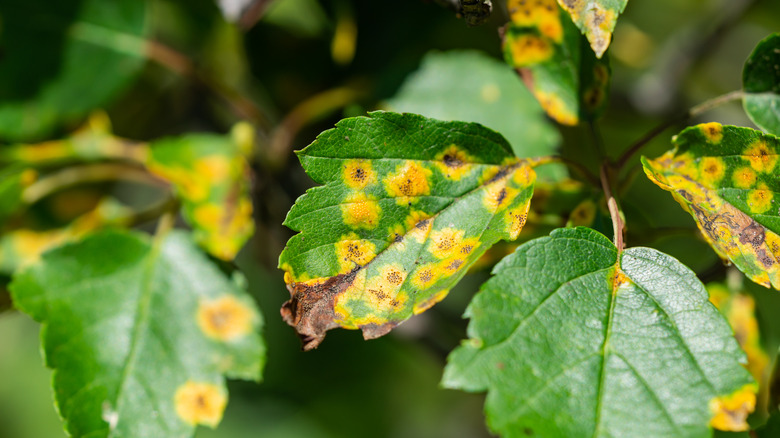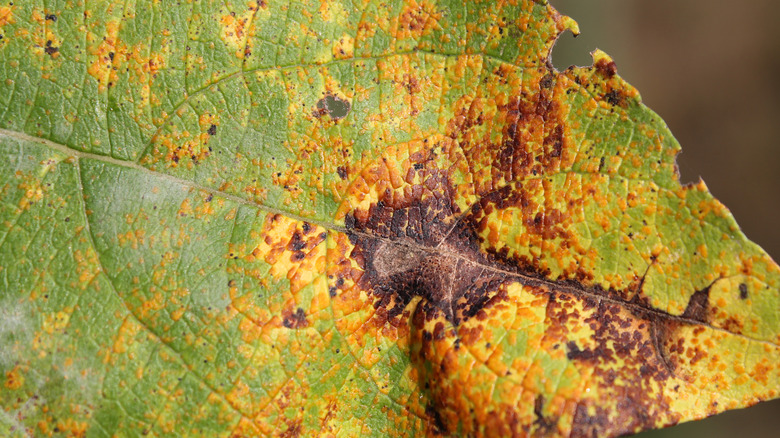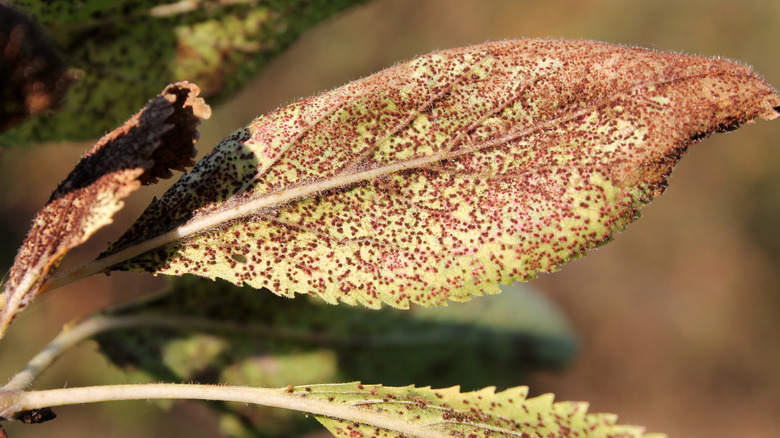What It Means If You See Rusty Orange Spots On Tree Leaves In Your Yard
If you're noticing rusty orange spots on the leaves of trees, it could be a type of fungal disease known as leaf rust. Fungi thrive in the shadowy, moist corners of our world and embody a vast, intricate network of species, each with a unique appetite for different hosts. For example, two common types of fungi that cause rust are Melampsora and Tranzschelia discolor. Melampsora is notorious for affecting willow, conifer, and poplar trees. On the other hand, Tranzschelia discolor usually affects peach trees, which is why it's also known as peach rust.
Understanding the fungal foe you're facing is more than a matter of curiosity — it's a critical step in devising a battle plan. Fungi are cunning adversaries, spreading their influence through microscopic spores that ride the winds or hitch a lift on water droplets to find new territories to colonize. These spores are like the seeds of the fungal world, landing on unsuspecting leaf surfaces and, under the right conditions, germinating to unleash their disruptive power on the host plant. Although fungi are the underlying cause of leaf rust across various trees, the severity and symptoms of the infestation can vary significantly. Each type of fungus demands a unique management strategy to mitigate and control the spread of the disease effectively. It's crucial to identify which type is affecting your tree. This will help you apply the most effective treatment and preventative measures to safeguard your trees against further damage.
Understanding Melampsora: symptoms and management
The symptoms of the Melampsora fungus are not hard to miss. Leaves develop orange or yellowish rustic spots and take on a discolored appearance, often curling and withering as if they've lost their will to thrive. In many cases, they may fall from the tree far earlier than nature intends. A severe attack by this fungus can lead to widespread loss of foliage, effectively stunting the tree's growth and leaving it vulnerable to a host of various diseases and pests. It's interesting to note that while the fungi don't spare conifers, the damage they do to these resilient tree species is usually far less dramatic than that of poplars and willows.
To prevent Melampsora rust, it's best to choose resistant tree species if they are available. This stands as a solid first line of defense, effectively nipping potential infections in the bud. In situations where the infection has settled in a localized area, a bit of timely pruning to remove infected branches can go a long way. Inspect your trees regularly and clear away any fallen, diseased leaves. Another trick is to play with space — literally. Ensure there's ample room between your trees to create an environment that's less hospitable to the spores of the fungi. And while reaching for chemical controls might not always be the first choice due to environmental concerns, the strategic use of preventative fungicides in more severe cases can provide a necessary shield to keep this aggressive fungus at bay.
Understanding Tranzschelia discolor: symptoms and management
Tranzschelia discolor or peach rust, usually affects both the lush leaves and the burgeoning fruits of trees (in this case, the peach tree). This particular fungus isn't indiscriminate in its spread; various climatic factors finely tune its impact. Hot regions frequently drenched by rain find themselves on the front lines of this battle, grappling with more severe infestations. Add these geographical nuances to bad soil health, and you have a recipe for outbreaks that can range from mild annoyances to full-blown catastrophes when growing a peach tree. The repercussions are far-reaching, with the potential to significantly dent both the quality and volume of the peach harvest — a scenario no grower ever wants to face. Thus, standing idly by is not an option; proactive management becomes the order of the day.
Addressing peach rust demands a preemptive stance — waiting until the orchard is in full distress is a gamble with high stakes. The foundational tactics are universal in their application; removing infected debris to halt further spread and promoting air circulation through strategic spacing can stave off the worst of it. Yet, the peculiarities of peach trees and the tenacity of the peach rust necessitate an additional layer of defense. This is where fungicides enter the picture, not in a one-off application but as part of a calculated regimen that may require several rounds of treatment, each employing different active ingredients to outmaneuver the pathogen. One example is rotating or tank-mixing various chemical protectants in line with their instructions.



